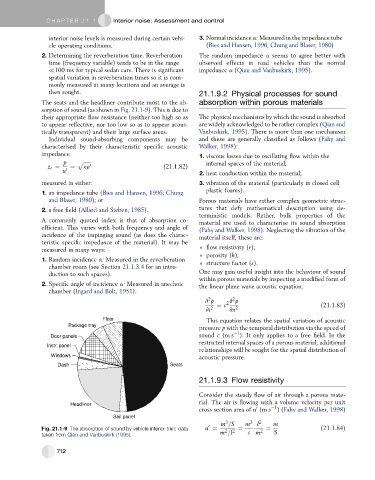Page 701 - Automotive Engineering Powertrain Chassis System and Vehicle Body
P. 701
CHAP TER 2 1. 1 Interior noise: Assessment and control
interior noise levels is measured during certain vehi- 3. Normal incidence a: Measured in the impedance tube
cle operating conditions. (Bies and Hansen, 1996; Chung and Blaser, 1980)
2. Determining the reverberation time. Reverberation The random impedance a seems to agree better with
time (frequency variable) tends to be in the range observed effects in road vehicles than the normal
100 ms for typical sedan cars. There is significant impedance a (Qian and Vanbuskirk, 1995).
spatial variation in reverberation times so it is com-
monly measured at many locations and an average is
then sought. 21.1.9.2 Physical processes for sound
The seats and the headliner contribute most to the ab- absorption within porous materials
sorption of sound (as shown in Fig. 21.1-9). This is due to
their appropriate flow resistance (neither too high so as The physical mechanisms by which the sound is absorbed
to appear reflective, nor too low so as to appear acous- are widely acknowledged to be rather complex (Qian and
tically transparent) and their large surface areas. Vanbuskirk, 1995). There is more than one mechanism
Individual sound-absorbing components may be and these are generally classified as follows (Fahy and
characterised by their characteristic specific acoustic Walker, 1998):
impedance 1. viscous losses due to oscillating flow within the
p p ffiffiffiffiffiffi internal spaces of the material;
z c ¼ ¼ kr 0 (21.1.82)
u 0
2. heat conduction within the material;
measured in either: 3. vibration of the material (particularly in closed cell
plastic foams).
1. an impedance tube (Bies and Hansen, 1996; Chung
and Blaser, 1980); or Porous materials have rather complex geometric struc-
2. a free field (Allard and Sieben, 1985). tures that defy mathematical description using de-
terministic models. Rather, bulk properties of the
A commonly quoted index is that of absorption co- material are used to characterise its sound absorption
efficient. This varies with both frequency and angle of (Fahy and Walker, 1998). Neglecting the vibration of the
incidence of the impinging sound (as does the charac- material itself, these are:
teristic specific impedance of the material). It may be
measured in many ways: flow resistivity (r);
porosity (h);
1. Random incidence a: Measured in the reverberation structure factor (s).
chamber room (see Section 21.1.3.4 for an intro-
duction to such spaces). One may gain useful insight into the behaviour of sound
within porous materials by inspecting a modified form of
2. Specific angle of incidence a: Measured in anechoic the linear plane wave acoustic equation:
chamber (Ingard and Bolt, 1951).
2
2
v p 2 v p
¼ c (21.1.83)
vt 2 vx 2
Floor This equation relates the spatial variation of acoustic
Package tray
pressure p with the temporal distribution via the speed of
1
Door panels sound c (m s ). It only applies to a free field. In the
restricted internal spaces of a porous material, additional
Instr. panel
relationships will be sought for the spatial distribution of
Windows acoustic pressure.
Dash Seats
21.1.9.3 Flow resistivity
Consider the steady flow of air through a porous mate-
rial. The air is flowing with a volume velocity per unit
Headliner
1
0
cross section area of u (m s )(Fahy and Walker, 1998)
Sail panel
3
m =S m 3 l 2 m
0
Fig. 21.1-9 The absorption of sound by vehicle interior trim: data u ¼ 2 2 ¼ $ 2 ¼ (21.1.84)
taken from Qian and Vanbuskirk (1995). m =l s m S
712

